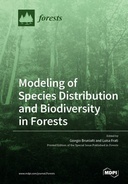Explore

Modeling of Species Distribution and Biodiversity in Forests
0 Ungluers have
Faved this Work
Login to Fave
Understanding the patterns of biodiversity and their relationship with environmental gradients is a key issue in ecological research and conservation in forests. Several environmental factors can influence species distributions in these complex ecosystems. It is therefore important to distinguish the effects of natural factors from the anthropogenic ones (e.g., environmental pollution, climate change, and forest management) by adopting reliable models able to predict future scenarios of species distribution. In the last 20 years, the use of statistical tools, such as Species Distribution Models (SDM) or Ecological Niche Models (ENM), allowed researchers to make great strides in the subject, with hundreds of scientific research works in this field. This book collects several research articles where these methodological approaches are the starting point to deepen the knowledge in many timely and emerging topics in forest ecosystems around the world, from Eurasia to America.
This book is included in DOAB.
Why read this book? Have your say.
You must be logged in to comment.
Rights Information
Are you the author or publisher of this work? If so, you can claim it as yours by registering as an Unglue.it rights holder.Downloads
This work has been downloaded 116 times via unglue.it ebook links.
- 116 - pdf (CC BY) at Unglue.it.
Keywords
- amphibian
- aridization
- association group
- beta diversity
- Biodiversity
- Biodiversity conservation
- Biology, Life Sciences
- biomod2
- Carabidae
- charcoal
- chlorophyll fluorescence
- Climate Change
- climatic change
- Conservation
- dispersal
- Dominant species
- ecological modelling
- Ecological Niche Model
- Ecological science, the Biosphere
- ecological sustainability
- ecological-phytocoenotic classification
- endangered
- ephemeral wetland
- epiphytic macrolichens
- Eucalyptus
- Euscaphis japonica
- fine-filter approach
- forest formation
- forest history
- Forest management
- forested wetland
- functional traits
- future spatial projection
- GARP
- Geographical information systems
- growth rates
- habitat
- habitat quality
- Habitat restoration
- habitat suitability model
- humid forest
- indicator species
- Landsat
- Last Glacial Maximum
- Life sciences: general issues
- macroinvertebrate
- Mathematics & science
- MaxEnt
- mediterranean area
- mixed forests
- Moscow Region
- n/a
- old-growth
- Paleoecology
- Permutation test
- Phylogenetic distance
- phylogenetic relationships
- Pinus mugo/uncinata
- Pinus nigra
- Pinus sylvestris
- potential suitable habitat
- pressure–state–response model
- protected areas
- quadrat counts
- Quantitative distribution
- Quercus pubescens
- Reference, information & interdisciplinary subjects
- Relative groups
- Research & information: general
- SDMtoolbox
- sexual reproduction
- Silviculture
- soil moisture
- spatial modeling
- species count data
- species distribution
- species distribution models
- species geographic distribution modeling
- stand structure
- tree diameters
- tree distribution patterns
- variation partitioning
- vegetative propagules
- Zooplankton
Links
DOI: 10.3390/books978-3-0365-1180-1Editions

